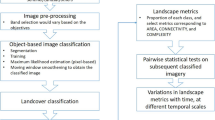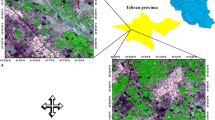Abstract
Context
Treeline-ecotone spatial patterns and their dynamics reflect underlying processes. Changes in ecotone pattern may reflect changes in natural drivers or land-use practices. However, characterizing these dynamics presents a major challenge, limiting our ability to map, understand and predict changes in the upper limits of mountain forests.
Objective
This paper proposes a new method using multiple pattern dimensions to describe treeline-ecotone spatial pattern shifts. This standardized protocol should be able to (i) distinguish different types of treeline-ecotone patterns within a large study area, (ii) characterize temporal pattern shifts in spatial pattern between two or more dates.
Method
We mapped alpine treeline ecotones (ATE) at 648 sites in the eastern French Pyrenees using aerial images from ~ 1955 and ~ 2015, identifying forest and non-forest areas at the hillslope scale. Extracted patch metrics were summarized using a Principle Component Analysis (PCA) and spatial pattern change was quantified from the shift in the PCA space and compared to elevational shifts.
Results
Three clusters of patterns were distinguished: diffuse, discrete and island-forming ATEs. Between 1955 and 2015, about half of the sites changed from one pattern cluster to another. Shifts into discrete ATEs were associated with smaller and negative elevational shifts, while shifts into diffuse ATEs coincided with the highest positive elevational shifts.
Conclusion
The proposed method allows a standardized and repeatable quantification of vegetation pattern change in alpine treeline ecotones based on historical aerial imagery. Seeing the importance of treeline-ecotone shifts for alpine biodiversity, we encourage the use of this protocol to better understand treeline dynamics at treelines globally.









Similar content being viewed by others
Notes
Mortality outside the ecotone or outside of existing forest patches could also be due to shade dependence or frost sensitivity of treeline tree species, i.e. stress rather than disturbance (Bader et al. 2021). However, in our study area all treeline ecotones were composed of P. uncinata, and climatic gradients were mild, so that different patterns were unlikely caused by such species-specific sensitivities and more likely by disturbance history.
References
Ameztegui A, Brotons L, Coll L (2010) Land use changes as major drivers of mountain pine (Pinus uncinata Ram.) Expansion in the Pyrenees. Glob Ecol Biogeogr 19(5):632–641
Ameztegui A, Coll L, Brotons L, Ninot JM (2016) Land use legacies rather than climate change are driving the recent upward shift of the mountain tree line in the Pyrenees. Glob Ecol Biogeogr 25(3):263–273
Ameztegui A, Morán-Ordóñez A, Márquez A, Blázquez-Casado Á, Pla M, Villero D et al (2021) Forest expansion in mountain protected areas: trends and consequences for the landscape. Landsc Urban Plann 216:104240
Bader MY, Rietkerk M, Bregt AK (2007) Vegetation structure and temperature regimes of tropical alpine treelines. Arct Antarct Alp Res 39(3):353–364
Bader MY, Llambí LD, Case BS, Buckley HL, Toivonen JM, Camarero JJ et al (2021) A global framework for linking alpine-treeline ecotone patterns to underlying processes. Ecography 44(2):265–292
Batllori E, Camarero JJ, Gutiérrez E (2010) Current regeneration patterns at the tree line in the Pyrenees indicate similar recruitment processes irrespective of the past disturbance regime. J Biogeogr 37(10):1938–1950
Beloiu M, Beierkuhnlein C (2019) Differences in the spatial structure of two Pinus cembra L. populations in the Carpathian Mountains. Forests 10(4):326
Bonanomi G, Rita A, Allevato E, Cesarano G, Saulino L, Di Pasquale G et al (2018) Anthropogenic and environmental factors affect the tree line position of Fagus sylvatica along the Apennines (Italy). J Biogeogr 45(11):2595–2608
Breiman L (2001) Random forests. Mach Learn 45(1):5–32
Camarero JJ, Gutiérrez E (2004) Pace and pattern of recent treeline dynamics: response of ecotones to climatic variability in the spanish Pyrenees. Clim Change 63:181–200
Camarero JJ, Gutiérrez E, Fortin MJ (2000) Spatial pattern of subalpine forest-alpine grassland ecotones in the Spanish Central Pyrenees. For Ecol Manag 134(1–3):1–16
Camarero JJ, García-Ruiz JM, Sangüesa-Barreda G, Galván JD, Alla AQ, Sanjuán Y et al (2015) Recent and intense dynamics in a formerly static Pyrenean treeline. Arct Antarct Alp Res 47(4):773–783
Cantegrel R (1986) Seuils écologiques et organisation biologique des pineraies alticoles de Pinus uncinata Ram: nouvelles perspectives en Néouvielle (Pyrénées occidentales) Bulletin de la Société Botanique de France. Actualités Botaniques. 133(1):193–208
Cantegrel R (2019) De l’origine des Pins de montagne européens. Revue forestière française 71(3):249–268
Coops NC, Morsdorf F, Schaepman ME, Zimmermann NE (2013) Characterization of an alpine tree line using airborne LiDAR data and physiological modeling. Glob Change Biol 19(12):3808–3821
Cossart E, Pic J, Le Guen Y, Fressard M (2020) Spatial patterns of vineyard abandonment and related land use transitions in Beaujolais (France): a multiscale approach. Sustainability 12(11):4695
Dearborn KD, Danby RK (2020) Spatial analysis of forest–tundra ecotones reveals the influence of topography and vegetation on alpine treeline patterns in the subarctic. Ann Am Assoc Geogr 110(1):18–35
Dial RJ, Maher CT, Hewitt RE, Sullivan PF (2022) Sufficient conditions for rapid range expansion of a boreal conifer. Nature. https://doi.org/10.1038/s41586-022-05093-2
Elliott GP, Cowell CM (2015) Slope aspect mediates fine-scale tree establishment patterns at upper treeline during wet and dry periods of the 20th century. Arct Antarct Alp Res 47(4):681–692
EnMAP-Box Developers (2019) : EnMAP-Box 3 - A QGIS Plugin to process and visualize hyperspectral remote sensing data. https://enmap-box.readthedocs.io
Escofier B, Pagès J(2008) Analyses factorielles simples et multiples: Objectifs, méthodes, et interprétation, Malakoff. France: Dunod
Feuillet T, Mercier D, Decaulne A, Cossart E (2012) Classification of sorted patterned ground areas based on their environmental characteristics (Skagafjörður, Northern Iceland. Geomorphology 139:577–587
Feuillet T, Birre D, Milian J, Godard V, Clauzel C, Serrano Notivoli R (2020) Spatial dynamics of alpine tree lines under global warming: what explains the mismatch between tree densification and elevational upward shifts at the tree line ecotone? J Biogeogr 47(5):1056–1068
Grafius DR, Corstanje R, Harris JA (2018) Linking ecosystem services, urban form and green space configuration using multivariate landscape metric analysis. Landscape Ecol 33(4):557–573
Harsch MA, Bader MY (2011) Treeline form–a potential key to understanding treeline dynamics. Glob Ecol Biogeogr 20(4):582–596
Herrera JM, Alagador D, Salgueiro P, Mira A (2018) A distribution-oriented approach to support landscape connectivity for ecologically distinct bird species. PLoS ONE 13(4):e0194848
Hesselbarth MHK, Sciaini M, With KA, Wiegand K, Nowosad J (2019) Landscapemetrics: an open-source R tool to calculate landscape metrics. Ecography 42:1648–1657
Hofstede RGM, Dickinson KJM, Mark AF, Narváez E (2014) A broad transition from cloud forest to páramo characterizes an undisturbed treeline in Parque Nacional Llanganates, Ecuador. Arct Antactic Alp Res 46(4):1–12
Holtmeier FK, Broll G (2005) Sensitivity and response of northern hemisphere altitudinal and polar treelines to environmental change at landscape and local scales. Glob Ecol Biogeogr 14(5):395–410
Holtmeier FK, Broll GE (2007) Treeline advance-driving processes and adverse factors. Landsc Online 1:1–33
Holtmeier FK, Broll G (2019) Treeline research—from the roots of the past to present time. A review. Forests 11(1):38
Humphries HC, Bourgeron PS, Mujica-Crapanzano LR (2008) Tree spatial patterns and environmental relationships in the forest–alpine tundra ecotone at Niwot Ridge. Colo USA Ecol Res 23(3):589–605
Kassambara A, Mundt F(2020) factoextra: Extract and visualize the results of multivariate data analyses. R package version 1.0.7. https://CRAN.R-project.org/package=factoextra
Körner C (2012) Alpine treelines: functional ecology of the global high elevation tree limits. Springer Science & Business Media
Körner C, Paulsen J (2004) A world wide study of high altitude treeline temperatures. J Biogeogr 31(5):713–732
Kupfer JA (2012) Landscape ecology and biogeography rethinking landscape metrics in a post-FRAGSTATS landscape. Prog Phys Geogr 36(3):400–420
Le S, Josse J, Husson F (2008) FactoMineR: an R package for multivariate analysis. J Stat Softw 25(1):1–18
Lin YP, Chang TK, Wu CF, Chiang TC, Lin SH (2006) Assessing impacts of typhoons and the Chi-Chi earthquake on Chenyulan watershed landscape pattern in central Taiwan using landscape metrics. Environ Manage 38(1):108–125
Malandra F, Vitali A, Urbinati C, Weisberg PJ, Garbarino M (2019) Patterns and drivers of forest landscape change in the Apennines range, Italy. Reg Envriron Chang 19(7):1973–1985
McGarigal K, Tagil S, Cushman SA (2009) Surface metrics: an alternative to patch metrics for the quantification of landscape structure. Landscape Ecol 24(3):433–450
McGarigal K(2015) FRAGSTATS help. University of Massachusetts: Amherst, MA, USA, 182
Métailié JP, Paegelow M(2004) Land abandonment and the spreading of the forest in the eastern French Pyrenees in the nineteenth to twentieth
Milian J, Eychenne C, Barthe L (2012) Du symbole à l’action: agriculture et pastoralisme dans la politique du Parc naturel régional des Pyrénées Ariégeoises. Sud-Ouest Européen. Revue Géographique des Pyrénées et du Sud-Ouest 34:51–64
Morley PJ, Donoghue DN, Chen JC, Jump AS (2020) Montane forest expansion at high elevations drives rapid reduction in non forest area, despite no change in mean forest elevation. J Biogeogr 47(11):2405–2416
Pedregosa F, Varoquaux G, Gramfort A, Michel V, Thirion B, Grisel O et al (2011) Scikit-learn: machine learning in Python. J Mach Learn Res 12:2825–2830
R Core Team (2022) R: A language and environment for statistical computing. R Foundation for Statistical Computing, Vienna, Austria. https://www.R-project.org/
Saulnier M, Cunill Artigas R, Foumou LF, Buscaino S, Métailié JP, Galop D, Py-Saragaglia V (2020) A study of late Holocene local vegetation dynamics and responses to land use changes in an ancient charcoal making woodland in the central Pyrenees (Ariège, France), using pedoanthracology. Veg History Archaeobotany 29(2):241–258
Schwarz N (2010) Urban form revisited—selecting indicators for characterising european cities. Landsc urban Plann 96(1):29–47
Sigdel SR, Liang E, Wang Y, Dawadi B, Camarero JJ (2020) Tree to tree interactions slow down himalayan treeline shifts as inferred from tree spatial patterns. J Biogeogr 47(8):1816–1826
Treml V, Chuman T (2015) Ecotonal dynamics of the altitudinal forest limit are affected by terrain and vegetation structure variables: an example from the Sudetes Mountains in Central Europe. Arct Antarct Alp Res 47(1):133–146
Treml V, Veblen TT (2017) Does tree growth sensitivity to warming trends vary according to treeline form? J Biogeogr 44(7):1469–1480
Vacquié L(2015) Modélisation prospective et échelles spatiales en montagne: application aux Pyrénées françaises (Doctoral dissertation, Université Toulouse le Mirail-Toulouse II)
Van der Linden S, Rabe A, Held M, Jakimow B, Leitão PJ, Okujeni A et al (2015) The EnMAP-Box—A toolbox and application programming interface for EnMAP data processing. Remote Sens 7(9):11249–11266
Wang Y, Pederson N, Ellison AM, Buckley HL, Case BS, Liang E, Camarero J (2016) Increased stem density and competition may diminish the positive effects of warming at alpine treeline. Ecology 97(7):1668–1679
Wardle P (2008) New Zealand forest to alpine transitions in global context. Arct Antarct Alp Res 40(1):240–249
Acknowledgements
This study was funded by the National Research Agency (ANR SpatialTreeP - https://anr.fr/Projet-ANR-21-CE03-0002) coordinated by Thierry Feuillet. We also benefited from the support of University of Paris 13 and the Pléiade laboratory.
Funding
The authors have not disclosed any funding.
Author information
Authors and Affiliations
Corresponding author
Ethics declarations
Conflict of interest
The authors have not disclosed any conflict of interests.
Additional information
Publisher’s Note
Springer Nature remains neutral with regard to jurisdictional claims in published maps and institutional affiliations.
Supplementary Information
Below is the link to the electronic supplementary material.
Rights and permissions
Springer Nature or its licensor (e.g. a society or other partner) holds exclusive rights to this article under a publishing agreement with the author(s) or other rightsholder(s); author self-archiving of the accepted manuscript version of this article is solely governed by the terms of such publishing agreement and applicable law.
About this article
Cite this article
Birre, D., Feuillet, T., Lagalis, R. et al. A new method for quantifying treeline-ecotone change based on multiple spatial pattern dimensions. Landsc Ecol 38, 779–796 (2023). https://doi.org/10.1007/s10980-022-01589-4
Received:
Accepted:
Published:
Issue Date:
DOI: https://doi.org/10.1007/s10980-022-01589-4




